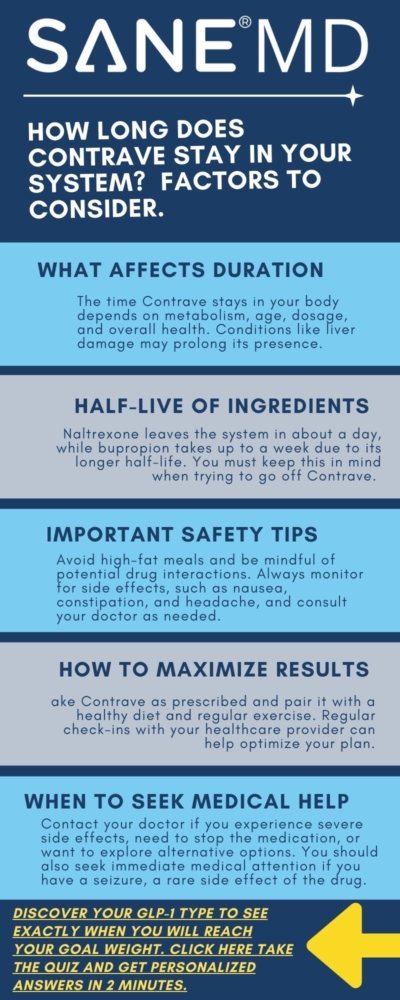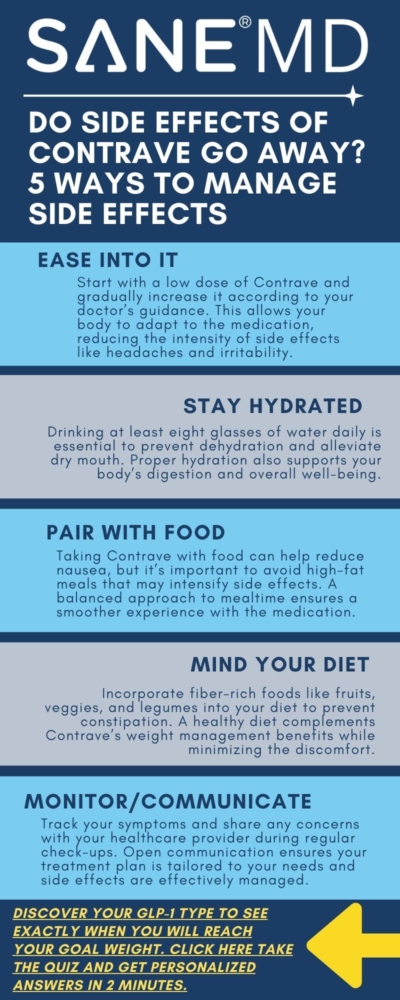How long does Contrave stay in your system?
If you’re asking ‘how long does Contrave stay in your system’, understanding its duration and elimination process is crucial. Contrave, a prescription medication for chronic weight management, contains a combination of naltrexone and bupropion, each with distinct pharmacokinetics that influences how long the drug stays in your system.
Factors such as dosage, metabolism, and overall health can affect the medication’s clearance from your body. Knowing this information can help you better manage your treatment plan and ensure the safe and effective use of Contrave.
Beyond its duration in your system, proper dosing, potential side effects, and a balanced lifestyle are essential to maximizing Contrave’s benefits. With the right approach and support from your healthcare provider, Contrave can be a valuable tool in your journey to improved health.
Key Takeaways
- Duration in the System: Contrave’s active ingredients typically leave the system within 5-7 days. However, this varies based on factors such as metabolism, age, dosage, and health conditions.
- Active Ingredients and Half-Life: Naltrexone has a half-life of about 4 hours, while bupropion has a longer half-life of approximately 21 hours. These factors influence how long the drugs remain in the body.
- Consultation is Crucial: Always consult a healthcare provider before starting, adjusting, or stopping Contrave to ensure safe and effective treatment tailored to your individual needs.
What is Contrave?
Contrave is a prescription medication used for chronic weight management in adults with a body mass index (BMI) of 30 or higher or those with a BMI of 27 or higher with at least one weight-related condition, such as high blood pressure, type 2 diabetes, or high cholesterol. It contains two active ingredients: naltrexone, an opioid antagonist, and bupropion, an antidepressant.
Contrave is designed to be used in combination with a reduced-calorie diet and increased physical activity to help compatible individuals lose weight and maintain weight loss.
Getting a Contrave Prescription
To get a Contrave prescription, you will need to consult with a doctor who will assess your weight loss needs and determine if Contrave is right for you. You can talk to a doctor online or in-person, and they will evaluate your medical history, weight, and other factors to determine if Contrave is a suitable treatment option for you.
If you are prescribed Contrave, you can fill your prescription at a pharmacy or through a mail-order pharmacy.
Key Ingredients and Mechanism of Action
Contrave combines two active ingredients:
- Naltrexone Hydrochloride: An opioid antagonist that reduces food cravings and plays a role in opioid withdrawal.
- Bupropion Hydrochloride: Primarily used to treat depression and assist in smoking cessation, it also affects appetite regulation.
These ingredients work together to help regulate food intake and promote weight loss.
Consuming Contrave with a high-fat meal can increase the risk of side effects due to heightened absorption of the drug’s active ingredients.
Dosage and Administration
The recommended dosage of Contrave is one tablet taken orally in the morning for the first week, followed by one tablet in the morning and one tablet in the evening for the second week. The dosage is then increased to two tablets in the morning and one tablet in the evening for the third week, and finally to two tablets in the morning and two tablets in the evening for the fourth week and beyond.
It is essential to follow the dosage instructions carefully and not exceed the recommended dose.
How Long Does Contrave Stay in Your System?
Factors Affecting How Long Contrave Stays in Your System
The duration Contrave remains in your body depends on various factors:
- Metabolism: Individuals with faster metabolisms process the drug more quickly.
- Age: Older adults may metabolize medications slower than younger individuals.
- Dosage: The maintenance dose and frequency of use impact how long the drug stays active.
- Health History: Medical conditions such as liver damage can prolong the drug’s presence in the body.
It requires about 5 half-lives for Contrave’s components to leave the body, with each half-life lasting approximately 21-24 hours.
Factors Affecting How Long Contrave Stays in Your System
| Factor | Impact on Duration in System |
|---|---|
| Metabolism | Faster metabolisms clear the drug more quickly. |
| Age | Older adults may metabolize medications slower than younger individuals. |
| Dosage | Higher or more frequent doses may extend the drug’s activity in the body. |
| Health History | Conditions like liver damage can prolong the drug’s presence in the system. |
Half-Life of Contrave’s Active Ingredients
- Naltrexone Hydrochloride’s half-life is approximately 4 hours. It takes several half-life cycles for it to completely leave your system.
- Bupropion Hydrochloride: This component has a longer half-life of about 21 hours, meaning it can take days to fully clear.
On average, it takes 5-7 days for most of Contrave’s components to leave the body. However, depending on individual factors, traces may linger longer.
Contrave Ingredient’s Half-Life
| Ingredient | Half-Life | Time to Leave System (Approx.) |
|---|---|---|
| Naltrexone Hydrochloride | ~4 hours | ~1 day (5 half-lives) |
| Bupropion Hydrochloride | ~21 hours | ~5-7 days (5 half-lives) |
Taking Contrave and Its Effects
How Contrave Works
Contrave suppresses appetite and helps reduce body weight in certain individuals when combined with a reduced-calorie diet and increased physical activity. It targets the brain’s reward system to decrease cravings.
Side Effects to Monitor
Taking Contrave may lead to side effects such as:
- Nausea and vomiting
- High blood pressure
- Suicidal thoughts or ideation (especially in young adults)
- Severe allergic reactions (e.g., rash, trouble breathing)
- Neuropsychiatric reactions
If you experience severe side effects or a medical emergency, contact your healthcare provider or local emergency services number immediately.
Important Considerations and Warnings: Drug Interactions
When taking Contrave, being aware of potential drug interactions, risks, and special circumstances is critical to ensure its safe and effective use.
Below is a more detailed breakdown of Contrave drug interactions:
Drug Interactions
Contrave’s active ingredients, naltrexone and bupropion, can interact with a variety of medications, potentially leading to adverse effects. Key points include:
- Opioids: Naltrexone blocks opioid receptors, making opioids ineffective for pain relief or recreational use. If you require opioid medications for acute or chronic pain, discuss alternative options with your healthcare provider before starting Contrave.
- Monoamine Oxidase Inhibitors (MAOIs): Using Contrave alongside MAOIs can lead to hypertensive reactions or serotonin syndrome. You must stop MAOIs at least 14 days before initiating Contrave.
- Antidepressants and Antipsychotics: Bupropion may increase the risk of seizures when combined with certain antidepressants or antipsychotic drugs. Inform your doctor about any medications you are taking for mental health conditions.
- Stimulants and Other Drugs: Combining Contrave with stimulants, such as those used for ADHD, or certain over-the-counter supplements can heighten seizure risk. Additionally, avoid alcohol, as it may also increase seizure risk and cause adverse mood effects.
Potential Risks
Contrave carries specific risks, which must be understood before starting treatment:
- Suicidal Thoughts and Behaviors: Like other medications that affect mood and brain chemistry, Contrave carries a warning for increased suicidal thoughts, particularly in young adults and during the initial stages of treatment. Regular mental health monitoring is essential, and any concerning changes should be reported immediately to your doctor.
- Hypertensive Reactions: Contrave can raise blood pressure and heart rate, making it unsuitable for individuals with uncontrolled hypertension. Routine blood pressure monitoring is critical during treatment.
- Seizures: Bupropion, one of Contrave’s ingredients, lowers the seizure threshold, especially when combined with certain medications or in individuals with a history of seizures. Dosing must be followed carefully to minimize this risk.
Who Should Not Take Contrave?
Contrave may not be suitable for everyone. Avoid using Contrave if you:
- Have a history of seizures, eating disorders, or uncontrolled hypertension.
- Are currently taking opioids or undergoing opioid withdrawal.
- Are pregnant, planning to become pregnant, or breastfeeding.
- Are taking monoamine oxidase inhibitors (MAOIs) or have used them within the past 14 days.
Always consult your healthcare provider to determine if Contrave is appropriate for your specific circumstances.
Pregnancy and Breastfeeding
Contrave is not recommended during pregnancy or breastfeeding.
Here’s why:
- Pregnancy: Weight loss during pregnancy is not typically advised, as it can harm both the mother and the developing fetus. Contrave has not been proven safe for use during pregnancy and should be avoided unless explicitly directed by a doctor.
- Breastfeeding: The active ingredients in Contrave can pass into breast milk and may affect the nursing infant. Mothers should consult their healthcare provider to determine the safest course of action.
Healthcare Assessment
A thorough evaluation by a healthcare professional is essential before starting Contrave to ensure it is safe and appropriate for your needs:
- Medical History: Conditions such as seizure disorders, uncontrolled hypertension, eating disorders, or a history of substance abuse may contraindicate the use of Contrave.
- Medications: Your doctor will assess any medications, supplements, or over-the-counter products you are taking to prevent adverse interactions.
- Ongoing Monitoring: Regular check-ins with your healthcare provider can help address any emerging concerns, adjust dosing, and optimize the effectiveness of your weight loss plan.
By understanding these considerations and maintaining open communication with your healthcare team, you can safely incorporate Contrave into your weight management strategy while minimizing potential risks.
Combining Contrave with a Balanced Lifestyle for Chronic Weight Management
For optimal results, Contrave should be paired with:
- A Reduced-Calorie Diet: Helps enhance weight loss.
- Regular Physical Activity: Supports weight management and overall health.
- Monitoring Blood Pressure: Essential for those with hypertension.
Additionally, it is important to avoid high-fat meals, particularly those containing eggs, avocado, peanut butter, or cheese, when taking Contrave to reduce the risk of side effects and complications.
Success Tips for Using Contrave
To get the most out of Contrave, consider these practical tips:
- Set Realistic Goals: Establish achievable weight loss milestones to maintain motivation and track progress effectively.
- Stay Consistent: Take your medication at the same times daily as directed by your healthcare provider.
- Keep a Journal: Document your food intake, exercise habits, and weight changes to monitor progress and identify patterns.
- Stay Hydrated: Drinking plenty of water supports overall health and helps manage appetite.
- Pair with Lifestyle Changes: Combine Contrave with a reduced-calorie diet and regular physical activity for the best results.
Lifestyle and Dietary Recommendations
To support your weight loss journey with Contrave, consider these lifestyle tips:
- Focus on Nutrient-Dense Foods: Prioritize lean proteins, legumes, fruits, and vegetables.
- Avoid High-Fat Meals: These can increase the risk of side effects and hinder medication absorption.
- Exercise Regularly: Incorporate activities like walking, swimming, or strength training to improve overall health.
- Manage Stress: Practice mindfulness, yoga, or deep breathing to reduce emotional eating triggers.
Alternative Weight Management Options
For individuals who are not candidates for Contrave, alternative weight management methods include:
- Other Prescription Medications: Medications such as phentermine or liraglutide may be recommended for weight loss in certain cases. See our guide for a comprehensive comparison between Contrave and Phentermine.
- Lifestyle Interventions: Focused programs that emphasize healthy eating, portion control, and regular exercise.
- Surgical Options: Bariatric procedures, such as gastric bypass or sleeve gastrectomy, may be suitable for those with severe obesity.
Discuss these options with your healthcare provider to find the best fit for your needs.
Frequently Asked Questions
Welcome to our Frequently Asked Questions section! Here, we address common concerns and provide clear, concise answers to help you better understand Contrave and its use.
Whether you’re starting treatment or have been on Contrave for a while, this guide is designed to provide helpful insights and support your journey.
1. What Is the Washout Period for Contrave?
Contrave’s washout period, or the time it takes for the medication to fully leave your system, is generally about one week. This timeline reflects approximately five half-lives, each lasting 21-24 hours.
Individual factors like metabolism, dosage, and overall health may influence this duration, so consult your doctor for personalized guidance.
2. Can I Just Take One Contrave a Day?
Contrave is formulated to work best when taken according to its prescribed dosing schedule. Taking less than the recommended dose could decrease its effectiveness and may not provide the intended weight loss benefits.
To achieve the best results, follow your healthcare provider’s instructions carefully.
3. Does Contrave Stop Working After a While?
Some users may notice a plateau in the effects of Contrave over time, which could be linked to the body adapting to the medication or changes in lifestyle habits. This doesn’t necessarily mean the treatment has stopped working.
Discussing your progress regularly with your healthcare provider can help fine-tune your plan and maintain momentum in your weight loss journey.
4. What Happens When You Stop Taking Contrave?
When you stop taking Contrave, you may experience withdrawal symptoms or a return of challenges with appetite regulation. Abrupt discontinuation can also increase the risk of weight gain or exacerbate underlying conditions like depression.
To minimize potential risks, always consult your healthcare provider before stopping or altering your treatment plan. If necessary, they can guide you through a safe tapering process.
5. What should I do if I miss a dose of Contrave?
If you miss a dose, skip it and continue with your regular dosing schedule. Taking two doses to make up for a missed one can increase the risk of side effects, such as seizures. If you frequently have trouble remembering your doses, consider setting reminders or alarms to help you stay on track. Always consult your healthcare provider if you have concerns about your dosing routine.
6. Can I drink alcohol while taking Contrave?
It is advisable to avoid alcohol while taking Contrave. Alcohol can heighten the risk of side effects such as mood changes, dizziness, or seizures. Additionally, it can interfere with the medication’s effectiveness and may counteract your weight loss efforts.
If you choose to drink, do so in moderation and discuss your alcohol consumption with your doctor.
7. How soon can I expect results?
Weight loss results with Contrave vary between individuals, but many patients start to notice changes within the first few months. Consistency in taking the medication, combined with a reduced-calorie diet and regular physical activity, is key to seeing progress.
Remember, Contrave is not a quick fix but part of a comprehensive weight management plan. Consistent appointments with your healthcare provider can help you monitor and maintain your progress.
Conclusion
Understanding how Contrave works, how long it stays in your system, and its role in chronic weight management is essential for achieving your health goals. By following the prescribed dosing schedule, maintaining regular communication with your healthcare provider, and incorporating a balanced lifestyle, you can maximize the benefits of this medication.
Always prioritize safety by being aware of potential side effects and drug interactions. With proper guidance and commitment, Contrave can be an effective tool in your journey toward better health and well-being.
Do Side Effects of Contrave Go Away At All?
Contrave, a prescription medication used for weight management, is a drug combination of bupropion hydrochloride and naltrexone hydrochloride. While it is effective for a subset of individuals in supporting weight loss goals, it’s essential to understand the side effects and how they might impact your experience with the drug. A common question is, “Do side effects of Contrave go away?” For many individuals, side effects diminish as the body adjusts to the medication, but this varies from person to person.
Additionally, it is crucial to disclose all medical conditions to your healthcare provider before starting Contrave to avoid increased side effects and dangerous drug interactions.
Key Takeaways
- Side Effects May Diminish Over Time: For many individuals, mild side effects of Contrave, such as nausea or headaches, often subside within a few weeks as the body adjusts. However, serious side effects require immediate medical attention and consultation with a healthcare provider.
- Monitoring and Communication Are Essential: Regular check-ups and open communication with your doctor can help manage side effects, ensure safety, and tailor the medication to your individual needs, particularly if you have pre-existing conditions like high blood pressure or mental health concerns.
- Lifestyle Adjustments Can Help: Taking Contrave with food (but avoiding high-fat meals), staying hydrated, maintaining a healthy diet, and following a gradual dosing schedule can reduce side effects and enhance the medication’s effectiveness for weight management.
Do Side Effects of Contrave Go Away? Understanding Contrave and Its Side Effects
Contrave is a prescription medication for weight management. It is specifically designed to help compatible individuals with obesity or overweight conditions lose weight and maintain it. It consists of two active ingredients: naltrexone and bupropion.
Naltrexone is used to treat alcohol and opioid dependence, while bupropion is an antidepressant prescribed for smoking cessation. The combination of these two ingredients aims to reduce appetite and control cravings, making it easier for individuals to stick to a healthy diet and exercise routine.
However, like any medication, Contrave can cause side effects ranging from mild to severe. Common side effects include nausea, constipation, headache, insomnia, and increased blood pressure. In rare cases, Contrave can cause serious side effects, such as suicidal thoughts and behaviors, liver damage, and seizures. The seizure risk is increased if Contrave is taken with other drugs that also lower the seizure threshold, such as Suboxone.
Before starting treatment, it is essential to understand the potential side effects of Contrave and discuss any concerns with a healthcare provider.
Common Side Effects of Contrave
When taking Contrave, some side effects are more common and tend to subside as your body adjusts to the medication.
These include:
- Nausea
- Headaches
- Trouble sleeping
- Blurred vision
- Dry mouth
For most patients, these symptoms may improve within a few weeks of starting Contrave as the body adjusts to the medication.
Serious Side Effects to Watch For
While many side effects are mild, some can be life-threatening and require immediate medical attention.
Serious side effects include:
- Increased blood pressure (Learn more about how Contrave can increase blood pressure in our guide.)
- Serious allergic reaction (e.g., hives, trouble breathing, swelling of the face or throat)
- Dark urine
- Severe mood changes or suicidal thoughts and behaviors
- Eye pain or changes in vision
If you experience any of these symptoms, seek medical care promptly.
Managing Side Effects of Contrave: A Quick Reference Guide
| Side Effect | Management Strategy | Why This Helps |
|---|---|---|
| Nausea | Take with food, but avoid high-fat meals. | Reduces stomach irritation and minimizes drug absorption spikes. |
| Dry Mouth | Stay hydrated; aim for 8+ glasses of water daily. | Prevents dehydration and alleviates the sensation of dryness. |
| Headaches | Start at a low dose and gradually increase. | Allows the body to adjust to the medication, reducing the severity of headaches. |
| Constipation | Maintain a fiber-rich diet and stay active. | Improves digestion and promotes regular bowel movements. |
| Trouble Sleeping | Avoid caffeine in the evening and create a bedtime routine. | Reduces stimulants and helps establish a consistent sleep schedule. |
High Blood Pressure and Contrave
Contrave can lead to an increased risk of high blood pressure and faster heart rate in some individuals, making it important to monitor cardiovascular health closely while on this medication. Additionally, individuals taking beta-blockers should be aware of potential Contrave and Metoprolol drug interactions, as well as Contrave and Amlodipine Drug Interactions, as combining these medications may impact blood pressure regulation and heart function.
People with a history of high blood pressure or heart conditions should consult their healthcare provider before starting Contrave.
Regular check-ups and blood pressure monitoring are essential to ensure safety. If Contrave causes a significant increase in blood pressure, your doctor may adjust your dose, recommend additional treatments, or explore alternative weight management options.
Maintaining a healthy lifestyle, including a low-sodium diet and regular exercise, can further help manage blood pressure levels while taking Contrave.
How Long Do Contrave Side Effects Last?
The duration of side effects can vary:
- Mild Side Effects: Often resolve within a few weeks as the body adjusts.
- Serious Side Effects: Require immediate attention and may persist longer if not addressed.
It’s crucial to monitor your symptoms and discuss any concerns with your healthcare professional.
Risk Factors and Warnings
Before starting Contrave, it’s important to discuss your medical history with your doctor, particularly if you have any of the following:
- High blood pressure
- Bipolar disorder
- Eating disorders
- Low blood sugar: Patients with diabetes should be particularly cautious, as Contrave can increase the risk of hypoglycemia. Monitoring blood sugar levels and recognizing symptoms is crucial to prevent severe consequences.
- Alcohol use
- Other medications that may interact with Contrave, such as Vyvanse, or Ritalin, which is typically used to treat ADHD and binge eating disorder, Effexor, commonly prescribed for depression, Xanax, a sedative drug used for anxiety, Nardil, an MAOI typically used for depression, and propranolol, used to treat high blood pressure. Another antidepressant, Paxil, can also interact with Contrave. Even certain antibiotics can interact with Contrave.
Be aware of the boxed warning related to suicidal thoughts and behaviors, particularly in younger individuals.
Interactions and Precautions
Contrave can interact with other medications, including blood thinners, opioids like morphine, hydrocodone, or hydromorphone, certain antidepressants, epilepsy medications like Tegretol, and medications for high blood pressure. If taking Contrave and Qsymia together, drug interactions can be particularly dangerous, as can taking Contrave and Mounjaro together, or Contrave and Fentanyl. Additionally, patients taking Contrave alongside certain neurological medications should be aware of potential Contrave and Lamictal drug interactions, as these combinations may impact seizure risk, mood stability, and blood pressure regulation. Antipsychotic drugs like Haldol can interact with Contrave as well. Also, individuals who smoke or use nicotine products should be aware of potential Contrave and nicotine drug interactions. It can also interact with certain stimulants, like Ephedrine. “Natural” herbal supplements like St. John’s Wort can also interact with Contrave.
You should also be cautious when using common over-the-counter medications, such as ibuprofen or naproxen, and familiarize yourself with potential Contrave and NSAIDs drug interactions, as combining these medications could pose additional health risks.
Contrave can also increase the risk of suicidal thoughts and behaviors, particularly in individuals with a history of mental health disorders. The combination of Contrave and Cymbalta , as well as Celexa and Contrave, can increase this risk. It is crucial to monitor mood changes and to seek immediate medical attention if you experience any symptoms of depression or suicidal thoughts.
If you are considering using CBD while taking Contrave, it’s important to understand potential interactions. Learn more about possible risks in our guide: Can I Take CBD with Contrave?
Additionally, Contrave and caffeine can interact in disturbing ways, especially if the latter is consumed excessively.
Before starting Contrave, it is essential to inform your healthcare provider about all medications, including prescription and over-the-counter medications, vitamins, and supplements.
See our guide to learn more about Contrave side effects and safety considerations.
Managing Side Effects
Here are detailed steps to help manage and reduce the side effects of Contrave effectively:
1. Take with Food
Taking Contrave with food can help minimize common gastrointestinal side effects such as nausea or stomach upset.
However, avoid consuming high-fat meals when taking the medication, as they can increase the absorption of the drug, potentially leading to intensified side effects like dizziness or nausea.
2. Start at a Low Dose
Follow your doctor’s recommendation to start with a low dose of Contrave and gradually increase it.
This titration process allows the body to adapt to the medication, reducing the likelihood of severe side effects such as headaches, irritability, or sleep disturbances.
3. Avoid Drinking Alcohol
Alcohol can amplify Contrave’s side effects, including dizziness, drowsiness, and mood changes. If you consume alcohol regularly or have concerns about its interaction with Contrave, consult your healthcare provider for personalized advice.
They can provide guidance on how to safely manage your alcohol intake while on the medication.
4. Healthy Diet
A balanced, reduced-calorie diet not only enhances the weight-loss benefits of Contrave but also helps minimize side effects like constipation or bloating.
Focus on fiber-rich foods, lean proteins, and plenty of vegetables to support digestion and overall health.
5. Inform About All Medications
Provide your doctor with a complete list of all medications, supplements, and over-the-counter products you are taking. Certain drugs can interact with Contrave, increasing the risk of serious side effects like seizures or heart complications. Even OTC drugs like Tylenol can interact with Contrave, resulting in unpleasant or dangerous symptoms.
Transparency ensures your doctor can prescribe the safest and most effective treatment plan.
6. Hydration
Staying well-hydrated is essential to counteract common side effects like dry mouth and to support your body’s overall digestion and metabolism.
Aim to drink at least 8 glasses of water daily, and consider electrolyte-enhanced beverages if you engage in vigorous exercise or lose fluids.
7. Talk with Your Doctor
Always communicate openly with your healthcare provider about your experience with Contrave.
If side effects are severe, persistent, or impacting your quality of life, your doctor can adjust your dosage, recommend lifestyle changes, or explore alternative treatments tailored to your needs.
FAQs About Contrave Side Effects
Contrave, a prescription medication for weight management, combines naltrexone and bupropion to help control cravings and overeating. While it can be an effective tool for certain individuals, like any medication, it may come with side effects that vary from mild to more serious.
This FAQ addresses common concerns about adjusting to Contrave, managing side effects, and ensuring safe use, helping you make informed decisions in collaboration with your healthcare provider.
1. When do I Seek Medical Attention?
If you experience any of the following symptoms while taking Contrave, seek immediate medical attention:
- Suicidal thoughts or behaviors – This can be a sign of a drug interaction, especially when taking Contrave and Zoloft together.
- Seizures or convulsions
- Liver damage symptoms, such as yellowing of the skin or eyes, dark urine, or severe stomach pain
- Allergic reactions, such as hives, itching, or difficulty breathing
- High blood pressure symptoms, such as chest pain, shortness of breath, or swelling in the legs
- Withdrawal symptoms, such as agitation, anxiety, or insomnia, after stopping Contrave
It is also essential to discuss any concerns or questions with a healthcare provider before starting Contrave. They can help you weigh the benefits and risks of the medication and monitor you for any potential side effects.
2. How Long Does It Take to Adjust to Contrave?
Most people begin to adjust to Contrave within two to four weeks. During this time, mild side effects such as nausea, dizziness, or trouble sleeping often subside as the body adapts to the medication. However, the adjustment period can vary depending on individual tolerance and health factors.
If side effects persist beyond a month or significantly impact daily life, consult your healthcare provider for guidance. They may recommend a modified dosing schedule or alternative treatments.
3. Can I Stop Taking Contrave Cold Turkey?
Stopping Contrave abruptly is not recommended, as it can lead to withdrawal symptoms or a sudden return of the conditions it was managing, such as overeating or cravings. In some cases, abrupt discontinuation may also cause side effects like mood swings or headaches.
It’s crucial to consult your doctor to create a safe tapering plan that gradually reduces your dosage. This ensures a smoother transition off the medication while minimizing potential adverse effects.
4. What Is the Downside of Contrave?
While Contrave can be effective for weight management, it does come with potential downsides. Common side effects include nausea, constipation, and headaches, but more serious risks, such as increased blood pressure or suicidal thoughts, can occur. These side effects can be triggered by drug interactions between Contrave and Buspar, or between Contrave and Methadone, for example. Contrave drug interactions can also occur with MAOI medications, such as Zyvox. Regular monitoring by a healthcare provider is necessary to ensure safety, particularly for individuals with pre-existing conditions like high blood pressure or mental health concerns.
Additionally, Contrave may not be suitable for everyone, especially those taking medications that interact with its active ingredients. If you’re also prescribed Rybelsus, be sure to read our guide on Taking Contrave and Rybelsus Together Drug Interactions to understand the potential risks.
5. How Can I Stop the Side Effects of Contrave?
To manage or reduce side effects of Contrave, start by discussing your symptoms with your doctor. They may recommend adjusting the dosage, as starting with a lower dose and gradually increasing it can help the body adapt. Taking the medication with food or at specific times of the day may also alleviate issues like nausea or insomnia.
If side effects persist or worsen, exploring alternative medications or weight management strategies with your healthcare provider may be necessary.
Final Thoughts
While Contrave is an effective tool for weight management, it is crucial to understand and manage its side effects. Always consult a licensed healthcare professional before making changes to your treatment plan. For more information, visit the FDA’s page on Contrave (opens in a new tab) or talk to your doctor about your concerns.



















